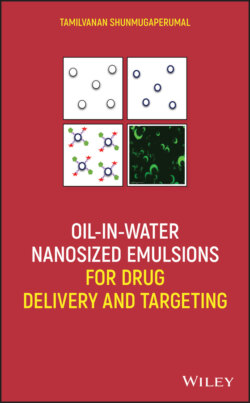Читать книгу Oil-in-Water Nanosized Emulsions for Drug Delivery and Targeting - Tamilvanan Shunmugaperumal - Страница 16
1.1.1. Nanotechnology: Definition
ОглавлениеPulverized API having nanometer size ranged particles and intact API‐loaded nanoparticles (either preformed or forming in situ) are considered one of the most‐prevalent improvement methods which have been used to overcome the problem of API's poor solubility and, thus, bioavailability, as well as to achieve targeted API delivery. Having said the importance of pulverized API as nanoparticles (NPs) or API‐entrapped nanoparticulate system, there is no single definition of what a NP is. This might be because of the highly multidisciplinary nature of nanotechnology. The term “nanotechnology” was first used by Norio Taniguchi in 1974, at the University of Tokyo, Japan, for any material in the nanometer size range (Taniguchi 1974) and the materials somehow handled by human beings in their everyday life. According to the United States Food and Drug Administration (USFDA), materials are classified as being in the nanoscale range if they have at least one dimension at the size range of approximately 1–100 nm. However, the characteristic properties of nanoscale such as solubility, light scattering and surface effects are predictable and even these properties are indeed continuous characteristics of the bulk materials (Donaldson and Poland 2013), the definitions of “nanomaterial” based on size are often inconsistent and the upper end of the nanoscale at 100 nm is an arbitrary cut‐off (Boverhof et al. 2015). Thus, the 100‐nm limit is often considered constraining and, according to a more‐inclusive definition, particles <1,000 nm in each dimension (submicron particles) is designated as NPs (Keck and Müller 2006). The latter more‐inclusive definition is particularly applicable in the pharmaceutical field since the particle size in the nanometer range can lead to increased dissolution rates because of the increase in surface area and increased saturation solubility (Junghanns and Müller 2008). In this respect, the generation of nanometer range particles from the API molecule itself is coming under NPs with a nomenclature of API nanocrystals or API nanosuspensions. On the other hand, encapsulating the API into a preformed or in situ forming nanosized API delivery carrier is also grouped under NPs. Now the question will arise, at an industrial environment, which type of API is going for API nanocrystals/nanosuspensions formation and which type of API needs to go as cargo in a nanosized carrier? To clarify this confusion, the following discussion is devoted wherein the poorly soluble API is grouped into two categories.
